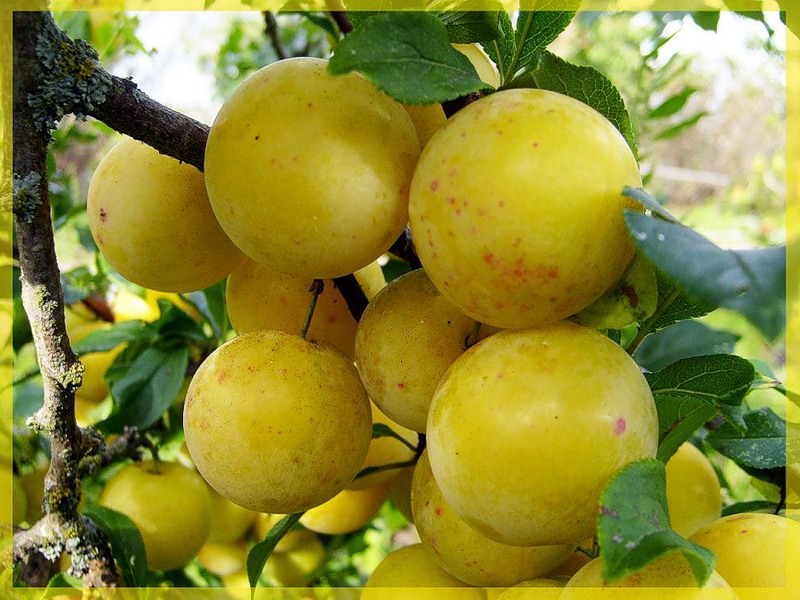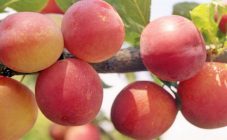Content:
Plum is grown in almost all European countries. This plant has no wild ancestors. It appeared in the Caucasus as a result of hybridization in natural conditions of cherry plum and blackthorn. Breeders have already bred more than 230 species of this fruit. One of the last was the Honey variety.
The history of the creation of the variety
Plum Honey yellow was created by scientists from Ukraine. The work on obtaining a hybrid was carried out in the Donetsk branch of the Institute of Horticulture at the Academy of Agrarian Sciences of the Republic under the leadership of L.I. Taranenko. Its name reflects the taste and color of the fruit.
The hybrid has another designation - White honey plum, which has stuck with the plant in some regions of the countries adjacent to Ukraine. Further development of the variety led to the creation of another hybrid called Orange Honey.
Plum Yellow honey: variety description
Plum belongs to the group of early-ripening fruit trees. Has the following parameters:
- The plant height in the southern regions of Russia reaches 5-6 m.In the middle zone of the country and its northern regions, the Belaya plum grows up to 3-4 m.
- The hybrid has few skeletal branches. A sparse, rounded crown is formed from them.
- The foliage is not too dense.
- White plum produces large fruits. Their average weight ranges from 40 to 50 g. Sometimes fruits of different sizes develop on one plant.
- The shape of this type of plum resembles a regular, slightly elongated sphere. The skin is thin, covered with a waxy coating.
- The fruits are bright yellow in color. Sometimes a blush appears on their surface.
- The flesh is the same color as the outside of the fruit. It contains a lot of sweet juice. Small white plum stone. It is difficult to separate it from the inside.
- The tree is resistant to drought and some diseases caused by fungal or viral infections.
- The hybrid is self-fertile, so it needs a pollinator for cross fertilization. For this, such species as Renklod Kuibyshev or Vengerka early are suitable.
Ripening of the variety occurs in early or mid July if the plant is planted in the south. In the northern regions, this process is postponed to early August. The yield of the hybrid is 30-35 kg per tree. Ripe fruits are harvested together with the stalks.
The high transportability of the Medovka plum (another variety name) allows the fruit to be transported over long distances. The hybrid is used in confectionery baked goods, canned and frozen.
Description of the plum variety Orange honey is as follows:
- the tree belongs to the group of plants with early ripening;
- the height of the hybrid reaches 3-5 m;
- the crown is oval;
- the flower buds of the plant have high frost resistance;
- rounded large fruits are colored bright yellow;
- average fruit weight 30-35 g;
- the bone is easy to separate from the pulp.
Orange honey is resistant to diseases such as gray fruit rot and perforated spot. The tree tolerates extreme heat well. The yield of the hybrid is 70 kg of fruit from each plant. These fruits can be transported over long distances. Use Orange Honey in the same way as White Plum.
Growing a hybrid
Plum Medovaya likes areas well lit by the sun, but trees should not be placed in wind-blown places.Therefore, experienced gardeners recommend planting plants on hillsides close to the fence or behind farm buildings.
Loose soil rich in organic matter works well for White Plum. The soil should be neutral in acidity.
If possible, then choose seedlings with a closed root system. Their length should be at least 60-70 cm. Trees with well-developed skeletal branches are acquired. There should be no cracks, chips, or rotten areas on the bark. It is better to pick up sprouts that are 2-3 years old, they will quickly take root in a new place.
If the roots of the hybrid are open, then their length should be 20-40 cm. Before planting, the plant is kept in moistened sawdust, wrapped in burlap. Before planting a tree in the ground, its lower part is soaked in water or a stimulant.
The seedling is placed in a prepared hole (depth 80 cm, diameter 0.6-0.7 m) in the fall in mid-September. Previously, organic fertilizers (manure, peat), river sand and sod are placed in the hole. A stake is installed in the center of the hole, on which the tree will rest during growth. They fill the hole with earth, make a circular groove with a shaft (height 0.4 m) around the seedling. Pour water (25-30 l) there. For irrigation, use only a warm liquid, set in the sun. A distance of 3-4 m is left between the trees, and passages of 4-4.5 m are maintained between the rows.
Further care
Caring for the White Plum should be systematic. In the spring, the tree is cleared of old branches, broken shoots. Cutting is carried out at 1/3 of the length. To prevent fungal infection, it is recommended to remove any leaves left after winter.
The first 2 years after planting, fertilization is not required for the hybrid. During this period, he consumes nutrients that were introduced into the pit when the tree was installed. In the third year, seedlings are fed as follows:
- organic and nitrogen fertilizers are applied in early spring;
- when flowers appear, potash mixtures are added to the soil;
- after the buds fall into the ground, phosphorus fertilizing is introduced.
After each use of these substances, you need to dig up the earth in the near-trunk hole, and then pour it with warm water. To protect against diseases, you need to destroy all weeds near the tree. The seedlings are hilled, the soil is loosened, and then mulched with peat (layer thickness 4 cm).
It is recommended to water the White Plum once a week. This will require 20-40 liters of water for each instance. The procedure is performed early in the morning.
In extreme heat, it is worth increasing the irrigation intensity by 2-3 times, but the near-trunk ditch should not be flooded. This will lead to the development of diseases and the loss of part of the crop.
To protect the seedlings from severe frosts, experienced gardeners recommend wrapping the trunks of the White Plum with burlap and cellophane. If the cold weather intensifies, then you can fumigate the plantings with smoke and additionally insulate the trees with thick cloth.
To destroy the pests that have appeared in the garden, you need to use drugs such as inta-vir, which kill well not only aphids, flies or butterflies, but also prevent caterpillars from breeding.
For the prevention of various diseases, you need to take the following measures:
- whitewash tree trunks with lime;
- treat their branches with Bordeaux liquid;
- remove all old and broken branches;
- burn last year's foliage.
If these procedures do not help, then the place affected by the fungi is cleaned and then treated with special preparations that destroy parasites. It is recommended to fight viral diseases with the help of special store products.
Advantages and disadvantages of the variety
The advantages of the hybrid are as follows:
- high productivity;
- large fruits;
- good frost resistance;
- ability to withstand drought;
- high resistance to various fungal and viral diseases.
Disadvantages of the variety:
- the need to install supports for branches;
- in extreme cold, it is required to wrap tree trunks with insulating materials.
The plum hybrid requires care and attention. Only with the correct organization of agrotechnical measures can a high yield be obtained. A gardener who wants to breed the described variety must do all the work in a timely manner in order to wait for the long-awaited harvest.
















